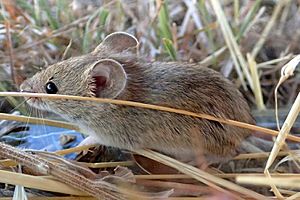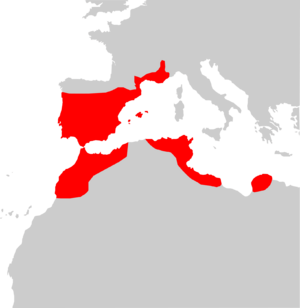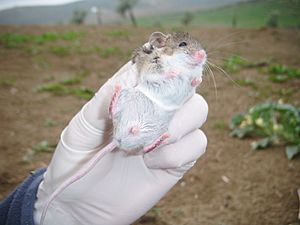Algerian mouse facts for kids
Quick facts for kids Algerian mouse |
|
|---|---|
 |
|
| Conservation status | |
| Scientific classification | |
| Genus: |
Mus
|
| Species: |
spretus
|
| Subspecies | |
|
|
 |
|
| Distribution range map of Mus spetrus | |
| Synonyms | |
|
Mus spicilegus spretus |
|
The Algerian mouse (Mus spretus) is a wild mouse that lives in open areas around the western Mediterranean Sea. It's also called the western Mediterranean mouse. This mouse is a close relative of the common house mouse, but it prefers to live in the wild, away from people.
Contents
What Does the Algerian Mouse Look Like?
The Algerian mouse looks a lot like a house mouse. The easiest way to tell them apart is by its shorter tail. Its fur is brownish on most of its body. However, its belly is a distinct white or light brown color.
These mice are about 7.9 to 9.3 centimeters (about 3 to 3.7 inches) long from head to body. Their tails are shorter, measuring 5.9 to 7.3 centimeters (about 2.3 to 2.9 inches). An adult Algerian mouse usually weighs between 15 and 19 grams (about 0.5 to 0.7 ounces).
Where Do Algerian Mice Live?
The Algerian mouse lives in southwestern Europe and along the western Mediterranean coast of Africa.
European Homes
In Europe, you can find them all over Portugal and most of Spain. They also live in southern France, especially near Toulouse and up the Rhone valley. They are also found on the Balearic Islands.
African Homes
In Africa, these mice live in the Maghreb region. This includes Morocco, Algeria, Tunisia, and western Libya. They live north of the Sahara desert. A small group also lives on the coast of eastern Libya.
Preferred Habitats
Algerian mice like open spaces. They avoid thick forests. They are most often found in temperate grasslands, arable land (farmland), and country gardens. They like areas with tall grasses or shrubs. These plants help hide them from animals that might hunt them. At the same time, they need plenty of open ground to move around. Even though they are wild animals and usually stay away from humans, they might sometimes be found in old, empty buildings.
How Do Algerian Mice Live?
Daily Habits, Food, and Dangers
Algerian mice are mostly active at night. They are omnivores, meaning they eat both plants and animals. Their main diet includes grass seeds, fruits, and insects. They don't need as much water to drink as house mice do.
Many animals hunt Algerian mice. These include owls, meat-eating mammals, and snakes.
Social Life and Territory
Male and female Algerian mice are often found in the same areas. This suggests they have a close connection to their environment. Older males tend to stay in one place when it's time to breed. This shows they have a territory. However, they don't fight fiercely to keep other mice out.
An adult male mouse's territory is about 340 square meters (about 3,660 square feet). This area often overlaps with the territories of nearby females. But it usually does not overlap with other males' territories. While they protect their main areas from other mice, they are less aggressive than house mice. They often show who is in charge through special behaviors instead of fighting. Females that are feeding their babies are more aggressive than other females.
Each male's territory overlaps with at least two female territories. How far mice travel each day changes. It depends on where they live, if they are male or female, their age, and the time of year. On average, they travel between 27.8 meters (91 feet) and 112.0 meters (367 feet) daily.
Algerian mice and house mice can live in the same general area. However, they usually do not share the exact same living spaces. They compete for resources, and Algerian mice tend to do better in very dry places.
These mice are very clean! They have been seen picking up their own droppings with their mouths. They also push them away with their noses from areas they use often. This clean behavior is quite different from their close relatives, the house mice.
How Do Algerian Mice Reproduce?
Algerian mice breed for nine months of the year, from February to October. They have two main times when they are very active in breeding. In April and May, adult mice from the previous year have new babies. Then, both these adults and their new young breed again in August and September.
A female mouse is pregnant for 19 to 20 days. She gives birth to two to ten pups, with about five being the average. The pups are born blind and without fur.
Growing Up
- Pups start growing fur when they are two to four days old.
- Their ears open at three to five days old.
- Their eyes open when they are 12 to 14 days old.
The young mice start eating solid food as soon as they can see. However, they are not fully weaned (stopped drinking milk) for about three or four weeks. They leave the nest soon after that. They reach their full adult size when they are eight to nine weeks old. Algerian mice have been known to live for up to 15 months.
Mating and Family Life
Male mice show strong loyalty to their usual mate. This happens no matter if the female is ready to have babies or not. It seems that one male and one female often form a stable pair. This might mean they have a social monogamous mating system, where they stay together. These pairs work together to build nests and defend their territory.
Male Algerian mice are usually larger and more aggressive than females. Females can get pregnant and have babies from their sixth or seventh week of life. Males, however, cannot fertilize a female until they are about eight weeks old.
Social interactions between male mice can change how much they are attracted to the smells of other male mice. For example, a male mouse that has met an unfamiliar male might be less attracted to that male's smell later. This change in how they sense smells could be important for choosing mates and other social behaviors. For instance, a male mouse might be less attracted to a female if she carries the smell of another male mouse.
In labs, male mice have been seen taking care of their young. This includes gathering and protecting them and sharing nests. In the wild, male mice not only care for their babies but also help defend their territory and find food.
How Are Algerian Mice Related to Other Mice?
Family Tree
There are five types of Mus (mouse) species that live in Europe. The M. musculus is the house mouse, which mostly lives in human homes. The Algerian mouse is one of the four wild species. Scientists are still learning about its exact relationship to the house mouse. It might be one of the earliest mouse species to branch off from the main group. Other European mouse species include the Macedonian mouse, the steppe mouse, and the Cypriot mouse.
Mixing Genes
Algerian mice are closely related enough to house mice that male house mice can have babies with female Algerian mice. This has only been seen in labs, not in the wild. This might be because the two species live in different places. Male babies from these pairings cannot have their own babies. However, female babies can. Interestingly, male Algerian mice do not mate with female house mice. They will even chase them away.
Ancient History
The oldest known fossils of the Algerian mouse are about 40,000 years old. They were found in Morocco. This, along with genetic evidence, suggests that the species first appeared in Africa. Later, they moved north into Europe. This might have happened when farming spread across Europe during the Neolithic period.
Hybridization: A Special Discovery
Scientists Michael Kohn and his team were studying mice in a German bakery. These mice were resistant to a poison called warfarin. They thought they were studying house mice. But when they looked at the mice's DNA, they found something amazing!
The mice had a lot of Algerian mouse DNA in their chromosomes. They also had a special gene called VKOR. This gene was thought to come from the Algerian mouse first. It helps mice survive even when they eat foods low in vitamin K. This gene also makes them resistant to warfarin.
This discovery was very important for understanding evolution. It was the first time scientists saw that mixing genes between two different species (called hybridization) could lead to something good. In this case, it helped the mice survive.
See also
 In Spanish: Ratón moruno para niños
In Spanish: Ratón moruno para niños



